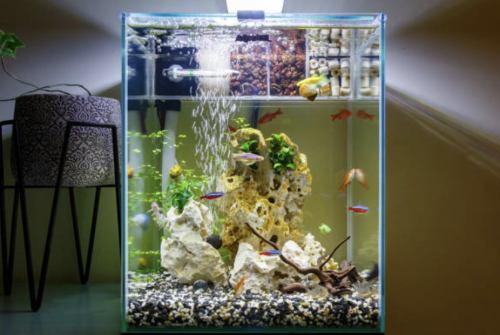
Adding an aquarium to your home is an excellent way of inviting some vivid color to your surrounding environment. Plus, observing and interacting with the fish inside of the aquarium can have some amazing health benefits for you such as reducing stress levels and lowering your blood pressure.
If you’re thinking about adding an aquarium to your home but aren’t sure where to begin, don’t panic! In addition to the amazing guides provided by The Aquarium Guide, this article has been curated to show you the first steps you need to take to start your home aquarium.
Find A Location
An aquarium cannot be placed in a random place in your home or on an uneven surface. A great place to put your aquarium will be on a cabinet or another sturdy piece of furniture.
You must pay attention to its location to ensure that it is strong enough to support the full weight of the aquarium and its equipment. Plus, a liter of fresh water weighs around a kilogram – so you must make sure the surface of the chosen surface is adequate to hold the weight.
An aquarium also requires proper lighting. This doesn’t mean it needs to be by the window but instead means it should be placed deep inside of the room so that direct sunlight doesn’t interfere with the life inside of the aquarium.
Add Gravel And Water
Add approximately one to two pounds of gravel for every gallon of water you add to your aquarium. You must make sure that the gravel is thoroughly rinsed before it is added to the home aquarium to remove any small particles including traces of debris, dust, or even poisonous residue from the factory where it was previously packaged.
The gravel bed inside of your aquarium should also gradually slope toward the front to add depth when viewing the tank.
Your tank should be filled to approximately one-third using room temperature water. Try adding a plate or a saucer on top of the gravel to keep everything in place and also adding a chlorine neutralizer to de-chlorinate the water.
Install Filter And Heater
Aquarium filters are supposed to be placed at a 45-degree angle near the maximum water flow. However, its exact position depends on the size and make of your aquarium.
The heater in smaller aquariums should be around 5 watts per gallon capacity of water. For example, a 20-gallon aquarium tank should have a 100-watt heater. Tanks over 40 gallons should generally have two heaters at opposite ends of the tank to ensure the water is uniformly heated. These should be installed under the water level.
You also need to attach a thermometer in a location that is both easy to monitor and access. At this stage, the installed equipment should not be plugged in.
Decorate
Once the technical equipment is installed you need to switch your focus to adding decorations. Not only do these add aesthetic value to your aquarium but they also work to provide your chosen fish with better living conditions.
You need to take the following decorations into consideration:
- A background which is used when an aquarium is positioned against a wall.
- Accessories including wood or stones. Make sure there are no sharp edges that could cause damage to the fish.
- The substrate that is part of the fish’s natural environment.
- Plants. These are not only an important part of decorating the tank but also play a huge part in the natural fish environment. Real plants may help to improve water quality and even purify it from toxins.
Add Your Chosen Fish
One of the most time-consuming parts of starting your own aquarium is acclimating your fish.
Add in the sealed plastic bag that your fish arrived in and let it float on top of the water in your aquarium for around ten minutes. You should then open the bag and add a cup of aquarium water to it. Reseal the bag, let it float for a while, and then keep repeating the process until the bag is full.
Use a net to transfer the fish from the bag into the aquarium. Don’t pour any of the water in the bag back into the tank!
Summary
Think of your fish as pets and you’ll likely be able to deliver better quality care to them. They rely on you to keep their environment clean, healthy, and conflict-free (yes, certain types of fish can get very territorial) so make sure you’re ready to take on this responsibility!
Interesting Related Article: “The Peaceful Water Aquarium For Schooling Fish“

